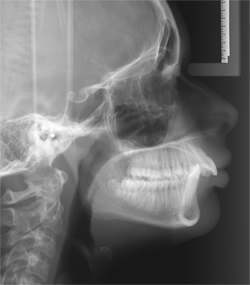Class II malocclusion
Class II malocclusions are divided into 2 categories:
- class II division 1: see description and definition further down this page
- class II division 2: see description and definition by clicking on the tab of the subpage.
Class II division 1

Class II division 1
A class II intermaxillary dental relationship represents a posterior discrepancy of the lower teeth with regard to the upper teeth. The embrasure between the lower canine and the lower first premolar is shifted backward with regard to the upper canine (blue arrows). The center of the lower first molar (mesiobuccal groove) is posterior to the first corner (mesiobuccal cusp) of the upper first molar (red arrows). The overjet reflects the anteroposterior discrepancy observed where the canines and the molars are (yellow arrow). The overbite is increased and, in the case shown above, the lower teeth are hidden completely by the upper teeth and touch the gingiva at the back of the upper teeth (green arrow). We call this type of deep dental overbite “supraocclusion”.
Occlusal view

Class II division 1 upper and lower occlusal views
Seen from above, the maxillary arch is narrower, because it needs to adapt to a more anterior portion of the mandibular arch which is positioned posteriorly with regard to the upper teeth. Interdental spaces can be seen on the maxillary arch. Note that some dental arches of patients in class II show more severe irregularities, because all categories of dental irregularities are possible. The blue arrows indicate where the lower incisors bite into the palate.
Cephalometric profile view

Class II division 1 retrognathic profile
This cephalometric X-ray shows the posterior discrepancy of the lower jaw. The upper teeth are more advanced compared to the lower teeth (a 11-mm overjet) and we can easily see that the lower incisors touch the palate at the back of the upper teeth on the palatal gingiva (10-mm overbite). The length of the face is shorter (distance between the tip of the nose and the bottom of the chin). The discrepancy between the upper and lower teeth makes the lower lip hem under the upper incisors.
The lower jaw is too short with regard to the upper jaw, making the lower teeth farther back with regard to the upper teeth.
This profile shows a dental class II relationship and a skeletal class II relationship. We call such relation “mandibular retrognathia”.
If we sum up the list of problems in the 3 planes in space, we find:
- A length problem: the lower jaw is too short,
- A height problem: the lower third of the face is shorter than normal,
- A width problem: the upper jaw is too narrow
Panoramic view

A patient’s dentition at 11 years and 7 months of age
This young patient’s dentition, for which we describe the above malocclusion, shows no particular problems. The third molars can be seen and are in development and we can predict that they will have no room to erupt normally in the mouth. They will presumably have to be extracted. The space between both upper incisors is visible and a little black radiolucent line testifies the absence of fusion of both hemimaxillae at this location. This separation is presumably caused by collagenous fibers composing the lingual frenulum (see the intraoral front view picture) which inserts into the intermaxillary suture.
Editor’s note: The human body has 2 maxillary bones. Both of these bones constitute what we call the upper maxilla. A hemimaxilla refers to either one of these bones that constitutes the upper maxilla.

Hi.
My Situation:
class 2 division 1, mild-moderate crowding on both arch, 5mm overjet, retroclined lower incisors, deep curve of spee, deep bite. both lips behind e-line, strong Chin, acute nasiolabial angle and labiomental angle.
Treatment: 4 first premolar extraction to relieve crowding. Space closure by moving upper incisors into extraction space and lower posterior teeth forward.
Upper lip should move in abit and improve the nasiolabial angle, and lower lip should not move in.
My concern is that I’m a few months into alignment, and the lower incisors seems to be retroclining more, and curve of spee getting deeper. I’m concerned about dished in lower lips.
I’m 20 years old and I suppose I’m non-growing? So Was wondering about the effects of class 2 elastics on people of my age group with regards to my aforementioned concern. would the elastic be able to move the lower incisors out and the lower lips out abit, improve lip support and increase labiomental angle? Or does it only work to bring the upper teeth in?
Also i have a square-ish face, and I heard class 2 elastics could cause backward jaw rotation/increase angle of mandible/increase anterior face height and decrease ramps height, and make the face more v-shaped? But is these only in growing patients?
Thank you!
Mild-moderate crowding, strong chin, deep labiomental angle, both lips behind e-line
CHances are that extraction of 1st premolar in a mild to moderate crowding situation may cause some retraction of the lips, hence increasing the apparence of a strong chin.
Moreover, you said you have a squarish face, this likely mean low mandibular plane angle. You have a deep bite + deep curve of spee. It may be very difficult to open the bite with extractions.
What was the reason to not trye a non extraction approach?
How can we identify class 2 camouflage?
Camouflage would mean dental compensation that camouflage the class II relationship. In some case we wnat to maintain the camouflage and it is why we can extract 2 upper premolars to finish class I Canine, class II molar.
Sometime we wnat to remove dental compensation, express the Class II relationship and correct the skeletal discrepancy by surgery.